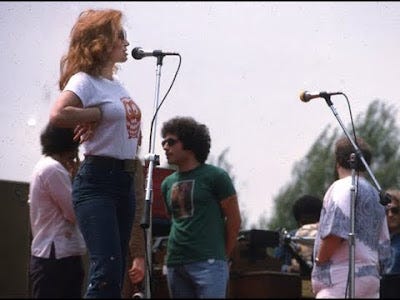The Alison Steele Method For Creating a Hit Late-Night Radio Show

How do you make a successful radio show, far from the prime-time hours? Follow these five steps Alison Steele took when she became a deejay for the first time.
by Rich Watson
Alison Steele (no connection to The Real Don Steele) deejayed late at night, removed from the more popular early morning breakfast hours or the afternoon commute home from work.
Yet during the seventies she amassed a substantial and loyal audience despite having no experience at the job.
She had to learn as she went.
Alison Steele: the Nightbird takes flight
The former Ceil Loman worked in New York media from the age of fourteen, first as a gopher in television, then as a producer in TV and radio. In the fifties she married bandleader Ted Steele. She co-hosted a radio show with him, Ted and the Redhead, before their divorce.
In July 1966, WNEW-FM launched in New York, playing standards. They tried an all-female deejay lineup as an experimental stunt.
Out of eight hundred applicants, Alison Steele was one of the finalists, along with:
Margaret Draper, an actress from radio and the stage
Arlene Kieta, a television actress,
Ann Clements, a former TV hostess,
Nell Bassett, a foreign children’s show host,
Pam McKissick, and
Peggy Cass, an Oscar-nominated actress.
The experiment lasted less than two years. Only Steele survived the cut.
In October 1967, the station format changed to progressive rock and the deejay lineup became more co-ed. Steele worked the late-night shift, 10 PM-2 AM, beginning in 1968. By 1971, the New York Times reported her audience was 78,000 strong.
How did she do it?
1. Adopt a cool nickname
With her new time slot, Steele wanted a new on-air persona to accompany it. What to call it?
The “night” meaning was obvious. She once characterized herself as a night person: “I think it has a mysterious quality. I never get lonely up here [in the studio].” “Bird” was British slang for a girl. Thus the “Nightbird” was born.
2. Set the right tone
Perhaps it was due to the early morning hours, when the WNEW studios were sparse. But something about the atmosphere inspired a gentle tone for Steele.
She’d begin her show with a bit of flute music and a few lines of poetry, mostly borrowed but sometimes original. Her intro invoked her new avatar:
Hello, Nightbird. How was your day? Did you visit the gods in the valleys far away? What did you bring me in your visit from the sea?
The flutter of wings, the shadow across the moon, the sounds of the night, as the Nightbird spreads her wings and soars above the earth into another level of comprehension, where we exist only to feel. Come fly with me, Alison Steele, the Nightbird, at WNEW-FM until dawn.
Or similar words.
3. Establish an agenda
According to this 1974 Daily News interview, Steele was cognizant of her listeners and their state of mind after midnight. She used her show to reach out to them:
People call me because they’re lost or upset… I try to point them in the right direction of self-help and love for oneself. I stress the idea that if you’re positive about things, you’ll enjoy what you have all the more. People call me when they have nowhere else to turn and I’m glad I can help. When I do hear from someone who’s troubled, I’m patient and understanding. I listen, ask no names and just give my particular brand of advice. I usually hear from those I’ve spoken to after awhile and they thank me. God, that makes me feel good! It’s fine to know you’ve helped somebody, somewhere, sometime.
In 1968, between the assassinations of Martin Luther King and Robert Kennedy, the chaos at the Democratic National Convention, and Vietnam, New Yorkers had quite a bit about which to feel anxious. Small wonder a soothing voice late at night on the radio came across as a balm.
Steele worked at WNEW until 1979. During the early eighties, she branched into writing and television, doing announcing and voice-over work. After a second tour of duty at WNEW she moved to WXRK, from 1989-95.
4. Play hip music
Progressive rock, not to be confused with progressive radio, had taken off around the time Steele joined WNEW.
Developed in the UK, it was psychedelic music taken to the next level, by musicians more versed in music theory than in simple three-chord blues. Literature, theater and graphic design were influences.
Steele played emerging prog-rock bands like
The Moody Blues,
Genesis,
Yes,
Emerson, Lake & Palmer and
Renaissance.
These bands were well-suited for WNEW, since their music emphasized long-form album tracks over radio-friendly singles.
5. Appear during the daytime once in awhile

———————
By the time of her death from cancer in 1995 (here’s an account of her struggle during those later years), she paved the way for more women deejays in New York and America. The Rock and Roll Hall of Fame inducted her.
She became the first woman to receive Billboard’s FM Personality of the Year Award, in 1976. Billboard also named its Lifetime Achievement Award for her (its first recipient was Casey Kasem).
Not bad for a beginner.
Plus: Get a celebrity endorsement, if possible
In 1971, Reprise released the Jimi Hendrix album Cry of Love posthumously. One of the tracks was called “Night Bird Flying.” His manager confirmed to Steele Hendrix wrote it for her.
He also drew this picture (NSFW).
@byrichwatson
————————
Did you listen to Alison Steele?

